2S1 Gvozdika
The 2S1 Gvozdika (Russian: 2С1 «Гвоздика», "Carnation") is a Soviet self-propelled howitzer based on the MT-LBu multi-purpose chassis, mounting a 122 mm 2A18 howitzer. "2S1" is its GRAU designation. An alternative Russian designation is SAU-122 but in the Russian Army it is commonly known as Gvozdika. The 2S1 is fully amphibious with very little preparation, and once afloat is propelled by its tracks. A variety of track widths are available to allow the 2S1 to operate in snow or swamp conditions. It is NBC protected and has infrared night-vision capability.
| 2S1 (SAU-122) | |
|---|---|
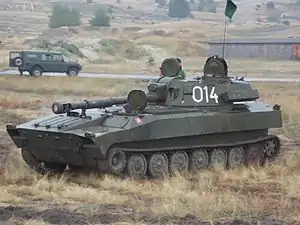 | |
| Type | Self-propelled artillery |
| Place of origin | Soviet Union |
| Service history | |
| In service | 1972–present |
| Used by | see Operators |
| Wars | Soviet–Afghan War Iran–Iraq War Gulf War War in Abkhazia (1992–1993) Yugoslav Wars Kosovo War First Chechen War Second Chechen War Iraq War 2008 South Ossetia War Russo-Georgian War First Libyan Civil War Second Libyan Civil War Syrian Civil War War in Donbass 2020 Nagorno-Karabakh conflict |
| Production history | |
| Designer | Kharkiv Tractor Plant |
| Designed | 1956-61 |
| Produced | 1971–1991 |
| No. built | more than 10,000 |
| Variants | see Variants |
| Specifications | |
| Mass | 16 tonnes (35,273 lbs) |
| Length | 7.26 m (23 ft 10 in) |
| Width | 2.85 m (9 ft 4 in) |
| Height | 2.73 m (8 ft 11 in) |
| Crew | 4 |
| Shell | 122 x 447mm .R separate loading, cased charge |
| Caliber | 122 mm |
| Breech | Horizontal sliding-wedge, semi-automatic |
| Elevation | -3 to +70 degrees |
| Traverse | 360 degrees |
| Rate of fire | Maximum: 5 rpm Sustained: 1-2 rpm |
| Muzzle velocity | 680 m/s (2,200 ft/s) |
| Maximum firing range | Conventional: 15.3 km (9.5 mi) Extended: 21.9 km (13.6 mi) |
| Armor | 20 mm (.78 in) |
Main armament | 2A18 122 mm (4.8 in) howitzer |
| Engine | YaMZ-238N diesel 220 kW (300 hp) |
| Suspension | torsion bar |
Operational range | 500 km (310 mi) |
| Maximum speed | Road: 60 km/h (37 mph) Off-road: 30 km/h (18 mph) Swim: 4.5 km/h (2.8 mph) |
Description
The 2S1 has seven road wheels on each side; the running gear can be fitted with different widths of track to match terrain. The interior is separated into a driver's compartment on the left, an engine compartment on the right and a fighting compartment to the rear. Within the fighting compartment the commander sits on the left, the loader on the right and the gunner to the front. The all-welded turret is located above the fighting compartment. The 2S1 utilizes a 122 mm howitzer based on the towed D-30 howitzer. The gun is equipped with a power rammer, a double-baffle muzzle brake and a fume extractor. It is capable of firing HE (high explosive), leaflet, HE/RAP, armor-piercing HE, flechette and chemical rounds.[1][2]
Production history
The first prototype was ready in 1958. The 2S1 entered service with the Soviet Army in the early 1970s and was first seen in public at a Polish Army parade in 1974. The vehicle was deployed in large numbers (72 per tank division, 36 per motorized rifle division). It was designated the M1974 by the U.S. Army and manufactured in Soviet, Polish and Bulgarian state factories.
Variants
Former Soviet Union/Russia
- 2S34 Hosta – Modernisation of the 2S1 with the 122 mm 2A31 gun replaced by the 120 mm 2A80-1 gun-mortar. Further improvements include a new Malakhit fire control system, a battlefield observation system and the ability to fire the Kitolov-2M guided ammunition. One unit, the 21st Mechanized Brigade in Totskoye is currently being equipped with the system.
- 2S15 Norov – A prototype tank destroyer equipped with a radar-based fire control system and a 100 mm gun.[3]
Ukraine
- Kevlar-E – Infantry fighting vehicle based on the 2S1 platform, equipped with Shturm remote weapon station and room for 6 passengers in addition to the 3 crew. The original 300 horsepower V8 diesel engine has been replaced with 420 horsepower diesel engine, produced by Caterpillar, Cummins or Deutz, increasing the maximum road speed to 70 km/h. Additionally, the vehicle is amphibious, includes air conditioning, a fire detection and suppression system, an NBC system, navigation system and night-vision equipment. The variant was first introduced in April 2018.[4]
Poland
The 2S1 Gvozdika (as well as other related vehicles such as the MT-LB and Opal) were produced in Poland by Huta Stalowa Wola under the name 2S1 Goździk.
- 2S1M Goździk – Version with special amphibious kit that increases the vehicle's amphibious capabilities.
- 2S1T Goździk – Version with a TOPAZ digital fire control system from WB electronics. The system consists of a FONET-IP digital intercom system, new digital radio, military GPS receiver, military computer and dedicated software. The same system is used on other Polish Armed Forces artillery systems like the AHS Krab, Dana-T and WR-40 Langusta.
Romania
Iran
- Raad-1 ('thunder') – Iranian variant that is based on the hull of the Boragh APC.
Myanmar
- 2S1U – In March 2019, a Ukrainian company and the Myanmar military have signed a joint-venture agreement to build a plant capable of manufacturing armored personnel carriers (APCs) and self-propelled howitzers. The types of APCs that will be made in the plant are said to be eight-wheeled BTR-4Us while the howitzers will be 2S1Us, which are based on the MT-LBu multipurpose chassis.[7][8]
Operators
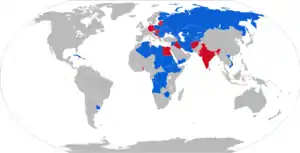

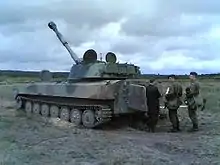

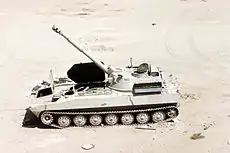
Current operators
 Algeria – 145
Algeria – 145 Angola
Angola Armenia – 20
Armenia – 20 Azerbaijan – 81 2S1 and unknown number of UR-77
Azerbaijan – 81 2S1 and unknown number of UR-77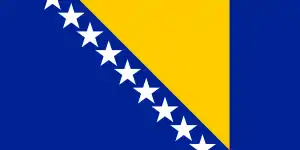 Bosnia and Herzegovina – 5
Bosnia and Herzegovina – 5 Belarus – 246[9]
Belarus – 246[9] Bulgaria – 506. In 2013 delivered 11 SPG from Poland[10]
Bulgaria – 506. In 2013 delivered 11 SPG from Poland[10] Chad - 10[11]
Chad - 10[11] Cuba
Cuba Croatia – 9 (to be used alongside 15 Panzerhaubitze 2000 from German Army stock)
Croatia – 9 (to be used alongside 15 Panzerhaubitze 2000 from German Army stock) Eritrea – 20[12]
Eritrea – 20[12] Ethiopia
Ethiopia Finland – 72 (known as 122 PsH 74). In 2013 three delivered from Poland.[13]
Finland – 72 (known as 122 PsH 74). In 2013 three delivered from Poland.[13] Georgia 48
Georgia 48 India – 110 (to be replaced)
India – 110 (to be replaced) Iran
Iran Iraq
Iraq Kazakhstan – 10
Kazakhstan – 10 Libya
Libya Moldova
Moldova Poland – 324 (to be replaced by SMK Rak and AHS Krab)
Poland – 324 (to be replaced by SMK Rak and AHS Krab) Russia – 622[14]
Russia – 622[14] Serbia – 72
Serbia – 72 Slovakia – 49
Slovakia – 49 South Ossetia
South Ossetia Syria – 400
Syria – 400 Transnistria
Transnistria Turkmenistan – unknown number in service as of 2016[15]
Turkmenistan – unknown number in service as of 2016[15] Ukraine – 638.[16] In June 2018 33 2S1 delivered from Poland and July 2019 16 delivered from Czech Republic.[17]
Ukraine – 638.[16] In June 2018 33 2S1 delivered from Poland and July 2019 16 delivered from Czech Republic.[17] Uruguay – 6 delivered in 1998 from Czech Republic[18]
Uruguay – 6 delivered in 1998 from Czech Republic[18] Uzbekistan
Uzbekistan Vietnam
Vietnam Yemen
Yemen
Former operators
 Czech Republic – Phased out in the early 2000s.
Czech Republic – Phased out in the early 2000s. Czechoslovakia – Passed on to successor states.
Czechoslovakia – Passed on to successor states. East Germany – Phased out in 1990 after German reunification.
East Germany – Phased out in 1990 after German reunification. Hungary – Phased out in 2004. Original there were 144 pieces of Gvozdikas.
Hungary – Phased out in 2004. Original there were 144 pieces of Gvozdikas. Islamic State – Reportedly; currently probably all destroyed.
Islamic State – Reportedly; currently probably all destroyed. Romania – 48 reserve status since 2005 (42 OAPR 89s and 6 2S1 Gvozdikas).
Romania – 48 reserve status since 2005 (42 OAPR 89s and 6 2S1 Gvozdikas). Slovenia – 8 reserve status.
Slovenia – 8 reserve status. Soviet Union – Passed on to successor states.
Soviet Union – Passed on to successor states..svg.png.webp) Yugoslavia – Passed on to successor states.[19]
Yugoslavia – Passed on to successor states.[19]
Combat history
- Afghanistan – Soviet–Afghan War
- Chechnya (Russia) – First Chechen War (1994–1996), Second Chechen War (1999 to 2000)
- Iraq – Iran–Iraq War, Gulf War, Iraq War
- Yugoslavia – Yugoslav Wars, Kosovo War
- Georgia – 2008 South Ossetia War
- Libya – First Libyan Civil War, Second Libyan Civil War
- Syria – Syrian Civil War[20]
- Ukraine – War in Donbass
See also
References
- Marat Kenzhetaev (1998). "Self Propelled Artillery and Mortars". armscontrol.ru. MIPT Center for Arms Control, Energy and Environmental Studies. Archived from the original on 2010-01-10. Retrieved 2010-05-03.
- "2S1 M-1974 122-mm Self-Propelled Howitzer". GlobalSecurity.org. 2008-11-09. Archived from the original on 2010-03-15. Retrieved 2010-05-03.
- "САУ 2С15 "Норов". СССР". Archived from the original on 2014-04-21. Retrieved 2014-05-09.
- Foss, Christopher F (29 April 2018). "Ukraine re-roles 2S1 SPH for infantry combat". IHS Jane's 360. London. Archived from the original on 1 May 2018. Retrieved 5 May 2018.
- http://www.worldwar2.ro/documents/004-artileria-romana-in-date-si-imagini.pdf, p. 164
- https://tanks-encyclopedia.com/coldwar-romania-model-89/
- "myanmar-ukrainian firming aims plant deal".
- "joint venture to supply ukrainian apcs to myanmar army".
- "Belarus Army Equipment" Archived 2017-02-16 at the Wayback Machine, GlobalSecurity
- https://www.altair.com.pl/news/view?news_id=14507
- IISS Military Balance 2020, p.469
- "Deagel.com". Archived from the original on 2008-11-21. Retrieved 2008-10-25.
- https://www.altair.com.pl/news/view?news_id=14507
- Eugene Yanko, Copyright 1997 – [email protected]. "2s1 Gvozdika Self-Propelled Howitzer | Russian Arms, Military Technology, Analysis of Russia's Military Forces". Warfare.ru. Retrieved 2011-08-18.
- Hərbi TV (31 October 2016). "Turkmenistan Military Parade 2016". YouTube (in Turkmen). Ashgabat. Archived from the original on 15 October 2017. Retrieved 7 August 2017.
- "Ground Forces Equipment – Ukraine". Archived from the original on 2017-07-07. Retrieved 2007-09-07.
- https://www.defence24.pl/kolejne-haubice-gozdzik-trafia-na-ukraine
- http://armstrade.sipri.org/armstrade/page/trade_register.php
- Kočevar, Iztok (August 2014). "Micmac à tire-larigot chez Tito: L'arme blindée yougoslave durant la Guerre froide" [The Yugoslav armored arm during the Cold War]. Batailles et Blindés (in French). No. 62. Caraktère. pp. 66–79. ISSN 1765-0828.
- https://www.youtube.com/watch?v=KeOQb21AsQo
- Trewhitt, Philip (1999). Armored Fighting Vehicles. New York, NY: Amber Books. p. 124. ISBN 0-7607-1260-3.
External links
| Wikimedia Commons has media related to 2S1 Gvozdika. |